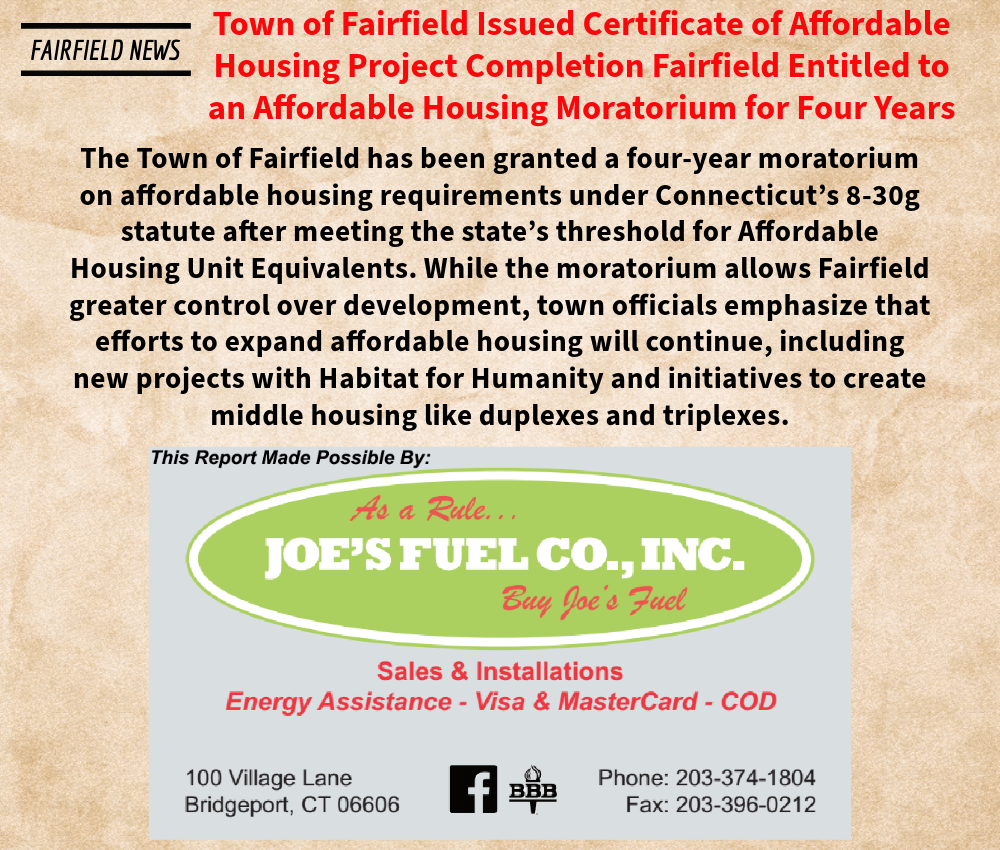
Fairfield, CT, —First Selectman Bill Gerber announced today that the State of Connecticut Department of Housing (DOH) has determined that the Town of Fairfield has met the requirements under Section 8-30g of the Connecticut General Statutes for a Certificate of Affordable Housing Project Completion and is entitled to a Moratorium of Applicability. The Moratorium of Applicability will begin on the next publication date of the Connecticut Law Journal, expected to be April 1, 2025, and will remain in effect for a four-year period.
The Town has made steady progress on the number of affordable housing units and submitted its application for a Certificate of Affordable Housing Project Completion on December 18, 2024. The application required proof that at least two percent of Fairfield’s 21,982 housing units, as reported in the 2020 Census, be documented as Affordable Housing Unit Equivalents (439.64 HUE). The application documented 462 HUE.
In the last decade, the Town has:
- Adopted an inclusionary zoning regulation that requires all developments resulting in ten or more dwelling units to set aside not less than ten percent of those units as affordable to persons or households with incomes at or below eighty percent of the area median income. The set-aside requirement is higher (12%) in the transit-oriented development overlay district.
- Established a dedicated Housing Trust Fund, which the Affordable Housing Committee has used to purchase property and make it available for new affordable housing developments.
- Enacted an inclusionary zoning fee of .005% on all new construction and building additions that don’t otherwise contribute to the Town’s affordable housing supply.
- Passed new zoning regulations making it easier to create accessory dwelling units in all residential districts except the Beach District and allowing detached ADUs.
- Utilized CDBG funds to help purchase properties conditioned upon their being affordable for a fixed term.
“Today’s announcement has been a long time in coming and is the culmination of many years of work,” commented Director of Community & Economic Development Mark Barnhart, noting that the Town’s application spanned some 600 pages and included documentation for some two dozen projects.
“While the moratorium represents a significant milestone, we know that it is only temporary, and that our work continues,” Barnhart added. “Further, we know that the need for more attainable housing options has never been greater; but, the good news on both counts is that we have a number of projects already approved or under construction that will allow us to continue to make progress on meeting our housing needs and qualifying for a subsequent moratorium.”
“During the upcoming moratorium, Fairfield can leverage greater control over the size and design of developments,” said First Selectman Bill Gerber. “We have been making steady progress in increasing our affordable housing inventory, mostly by increasing the number of units that are deed-restricted. Our goal is to continue to diversify Fairfield’s housing stock as we recognize the need for more housing choices for Fairfield’s residents.”
Fairfield’s most recent Affordable Housing Plan calls for the Town to explore ways to create “middle housing,” or multi-family developments built on a more modest scale, such as duplexes or triplexes, instead of multi-story apartment buildings. The Town’s partnership with Habitat for Humanity will add more middle housing with two new elevated duplexes at 385 and 402 Quincy Street. This will be the second Habitat project in Fairfield. The first is located at 244 Greenfield Street and is expected to be ready for occupancy in June 2025.
Barnhart noted that a number of pending development applications are considered “grandfathered” and must be considered by Town Plan and Zoning, as they were submitted before the moratorium took effect. Currently, the Town has ten pending applications filed under the State’s Affordable Housing Act. Should any of these applications be constructed, thirty percent of all units would be deed-restricted and available to income-eligible households.
